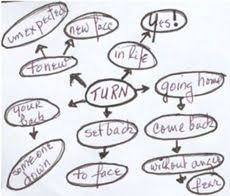
Whether you write memoir, fiction or nonfiction, you need anecdotes and scenes to illustrate your point. How can you know which moment is the right one to depict?
Writing Tip for Today: Here are some tips to help you choose compelling moments to illustrate:
Gabrielle Rico
The Gabrielle Rico method helps you to pinpoint a deeply compelling moment or scene to write into your work. Begin with a circled word in the middle of a page. This word might be abstract, like “love,” or it might be more specific, such as “how I learned to be unafraid of dogs.” Whatever you write in the middle of a blank page, draw spokes in a circular pattern and briefly name a specific event or moment in time that relates to the circled word.
Keep going with the spokes, growing more and more detailed with each level. At some point, your instincts should kick in to create an AHA! Emotional moment which best illustrates the central word. Be sure your AHA! Is deeply emotional in some way.
This kind of free association should resonate both for you and your intended audience. The secret to writing meaningful anecdotes/scenes is in choosing events or specific moments that appeal to readers in a profoundly emotional way.
Start Small
If you’re writing about a series of incidents to illustrate a larger point (whether in anecdotes or fictional scenes), start with the least tense or conflict and build up gradually. Even in nonfiction, you don’t want to lessen the reaction by putting the most emotional part first—you won’t have room to turn up the temperature.
Memoir writers and nonfiction writers can take a cue from fiction: a good story begins with a goal, obstacles and rising action all the way to a climax. If your memoir is about how you tried to save the trees, you can’t burn down the forest on page one. Instead, start with the emotional gut punch you felt that put you on the quest to save the trees.
Maybe you sensed that a small action or attitude would lead to a giant conflagration, and then something happens to reinforce that feeling. In fiction we call it an Inciting Incident. When you do a Ricco exercise, be on the lookout for what your inciting incident is like and write specifically about that AHA! Moment.
Gabrielle Rico and Writing the Natural Way helps you organize events into an AHA! moment.
Translate Emotions
An event that you identify as AHA! may be deeply personal. Your task is to translate the moment in terms that readers can identify with and relate to. Be prepared to show readers how and why this incident illustrates your central idea or theme or story arc.
If you write fiction, you can make your scenes memorable if they project human values that we all share: the need for love, acceptance, belonging or justice. If your protagonist desires only revenge, be sure to frame it with a cause that excuses or justifies such revenge. Most of the time, readers will accept a character who must avenge a wrong.
Readers will have a harder time with a character or thesis only bent on being a victim who seeks revenge. If you try to justify such a character or theme, you’ll need to be extra skillful at writing the character as more than a victim. When you do the RICO exercise, look for moments that back up the need for revenge. More than anything, look for AHAs that point your character or argument away from retribution and toward redemption.






I can’t thank you enough for linking to the book information. The Rico Method seems really helpful, and I definitely wanted to learn more about it.
Hi there,
I agree–especially if you’re stuck or you have competing scenes to think about, the RICO method is helpful.
Keep Writing,
Linda